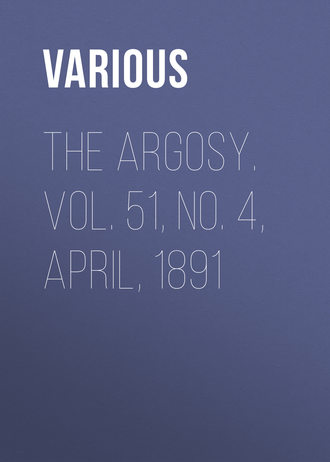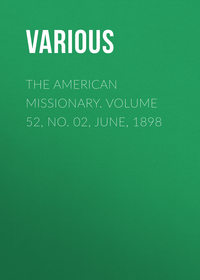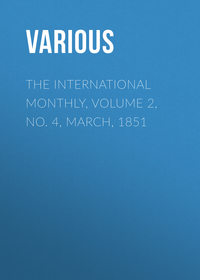 полная версия
полная версияThe Argosy. Vol. 51, No. 4, April, 1891
There was very little to notice in the country we passed through. The most conspicuous objects were the large stone crucifixes erected here and there by the roadside or where two roads met: ancient and beautiful; and throwing, as we have remarked, a religious tone and atmosphere over the country. It was wonderfully picturesque to see, as we occasionally did, a Brittany peasant kneeling at the foot of one of these old crosses, the pure white Brittany cap standing out conspicuously against the dark grey stone: a figure wrapped in devotion, apparently lost to the sense of all outward things. It all adds a charm to one's wanderings in Brittany.
St. Thégonnec at last, announced some time before we reached it by its remarkable church, which is very visible in the flatness of the surrounding country. The small town numbers some three thousand inhabitants, but has almost the primitive look of a village. Many of the people still wear the costumes of the place, especially on a Sunday, when the interior of the church at high mass looks very picturesque and imposing.
The dress of the women is peculiar, and at first sight they might almost be taken for nuns or sisters of mercy: a dress which leaves scope for a certain refinement rather contradicted by the physical appearance of the women themselves. Men and women, in fact, belong for the most part to the peasantry, and pass their simple lives labouring in the fields, beating out flax, cultivating their little gardens, so that such an official as the gravedigger becomes an important personage amongst them. We came across him, at his melancholy work, but could make no more of him than we made of the people of Roscoff. He understood no word of French, but spoke his own native tongue, the language of la Bretagne Bretonnante, as Froissart has it, in contradistinction to la Bretagne douce. Nothing, certainly, can be softer and more beautiful than the pure French language; but that of Brittany is hard and guttural, without beauty or refinement of any sort.
The men of St. Thégonnec dress very differently from the women, but the costume is also very characteristic. It is entirely black, and consists of wide breeches, pleated and strapped at the knee; a square tunic; a scarf tied round the waist, with loose ends; a large hat, and shoes with buckles.
To-day few inhabitants were visible. We seemed to be in possession of the place, together with the old gravedigger, who stopped his work and escorted us about, but was too stupid to understand even the most intelligent signs.
The church is very elaborate and fanciful, cruciform and sixteenth century, in the Renaissance style, much decorated with sculptures in dark Kersanton stone. The word Kersanton is Breton for St. Anthony's House; therefore we may suppose that the Saint had his house, and possibly his pig-stye, built of this same stone. For, as we know, St. Anthony had a weakness for pigs, and was famous for recovering one of his favourites from the devil, who had stolen it: recovered it not quite undamaged, as the animal was restored with his tail on fire: a base return for the Saint's politeness, who had offered his petition in poetical terms to which his audience could scarcely have been accustomed.
"Rendez-moi mon cochon, s'il-vous-plait,Il faisait toute ma félicité,"chanted the Saint, and to restore the pig with his tail on fire was conduct worthy only of fallen spirits.
But let us leave the Saint's pigs and return to our sheep.
The Kersanton stone, of which so many churches in Brittany are built, possesses many virtues, but one great drawback. It defies the ravages of time, yet is admirable for carving, yielding easily to the chisel. But time has no influence upon it. Centuries pass, yet still it remains the same: ever youthful, ever hard and cold. It knows nothing of the beauty of age; it does not crumble or decay, or wear away into softened outlines; it takes no charm of tone; no lights and shadows. A dark grey-green it was originally, and so it remains. Thus, in point of effect, a church built of Kersanton stone two centuries ago might, as far as appearance goes, almost have been built yesterday. This is a great defect; and interferes very much with the charm of some of Brittany's best churches. It is hard, cold and severe, without refinement, poetry or romance.
In some cases it atones somewhat by its richness and elaborateness of sculpture, as in the case of St. Thégonnec. The west front of this church is Gothic, of the fourteenth century. One of the turrets has a small, elegant spire, and at the S.W. angle there is a very effective domed tower bearing the date 1605.
You enter the churchyard by a triumphal arch, in Renaissance dated 1587. It is large and massive, with a great amount of detail substantially introduced, its summit crowned by a number of crosses. On the frieze St. Thégonnec is represented conducting a waggon drawn by an ox: a facsimile of the waggon that is said to have assisted in carrying the stone to build the church. St. Thégonnec is the patron saint of all animals, and to him the peasants appeal for success and good-luck in such matters.
Adjoining the triumphal arch is a Flamboyant ossuary or mortuary chapel, dated 1581, richly gabled, in perfect preservation, and of two storeys. The first consists of semicircular arches supported by small pillars with Corinthian capitals. A short staircase within leads to a crypt converted into a small chapel, in which is an entombment formed of life-size figures carved in wood, gilded and painted, bearing date 1702. The calvary in the churchyard, a remarkable monument, completes the history, by a multitude of small statues representing all the principal episodes of the Passion. Its date is 1610. Even the crosses are surmounted by statuettes, as if the designer had not known how to heap up sufficient richness of ornamentation. The carved pulpit in the interior of the church is also remarkable.
We could only devote an hour to St. Thégonnec; Guimiliau had still to be seen, and we wished to be back in Morlaix by a certain time, for "the night cometh." Fortunately the drive was not a long one.
Guimiliau is a village not half the size of St. Thégonnec, and is even less civilized. Into the inn, which no doubt is respectable, but was rough and primitive, we did not venture. The driver and the landlord were apparently on excellent terms, and whilst they fraternised over their glasses, we inspected the church.
The place takes its name from Miliau, a king of the Cornouaille, who was treacherously murdered by his brother Rivod, who then proclaimed himself king about the year 531. The church and the people canonised him, and he has become the patron saint of many a Breton village.
The church of Guimiliau dates chiefly from the sixteenth century. The aisles and the south porch are Renaissance, richly ornamented by delicate sculptures representing scenes from the Old and New Testament; statues of the Apostles. The triumphal arch and ossuary are very inferior to St. Thégonnec, but the calvary is a magnificent monument, unequalled in Brittany, richly sculptured and ornamented. It rests on five arches, and you ascend to the platform by a short staircase in the interior. Here are crosses bearing the Saviour, and the thieves, quaintly carved, but with a great deal of religious feeling. The Evangelists, each with his particular attribute portrayed, are placed at the angles: and the whole history of the Life of Christ is represented by a countless number of small figures or personages dressed in costumes of the sixteenth century. The effect is occasionally grotesque, but very wonderful. A procession armed with drums and other instruments precedes the Bearing of the Cross; and another scene which does not belong to the Divine Life, but was introduced as an accessory, represents Catel Gollet (the lost Catherine) precipitated by devils in the form of grotesques into the jaws of a fiery dragon emblematical of Purgatory.
Catel Gollet was one who concealed a sin in confession, was condemned to suffer, and returning miraculously in 1560 announced her condemnation to her companions in these terms:
Voici ma main, cause de mon malheur,Et voici ma langue détestable!Ma main qui a fait le péché,Et ma langue qui l'a nié.The bas-relief represents the Adoration of the Magi, and bears date 1588, whilst the upper part bears that of 1581.
The interior of the church possesses some wonderful and almost matchless carved wood, which surprised and delighted us. There were sixteenth century statues, full of expression, of St. Hervé and St. Miliau; an elaborate and beautiful pulpit, a font with a canopy supported by twisted columns, magnificently carved and thirty feet high, dated 1675; a matchless organ case, with three bas-reliefs, representing David, St. Cecilia and a Triumphal March, the latter reproduced from one of Alexander's battles by Lebrun.
In short, Guimiliau was a treasury of sculptured wood, which alone would have made it remarkable amongst churches. It was almost impossible to leave its fascination, and I fear that we more than envied the church its possession. It also came with a surprise, for we had heard nothing of this treasure of refined carving, and had anticipated nothing more than the wonderful calvary. It still lives in our imagination, almost as a dream; a dream of beauty and genius.
We lingered as long as we dared, but knew that we should not travel back at express speed, and that our coachman, after his indulgence in Breton beer or spirit, would probably be more sleepy than ever.
The sun was declining as we left Guimiliau, the church and its monuments forming a very singular composition against the background of the sky as we turned and gave it a farewell look. One scarcely analysed the reason, but there was almost an effect of heathendom about it, as if it dated from some remote age, when visible objects were worshipped, and the sun and the moon and dragons and grotesques took a prominent place in religion.
The sun was declining and twilight was beginning to creep over the land. It threw out in greater relief the wayside crosses that we passed on the road, solemnising the scene, and insensibly leading the mind to contemplation; all the beauty, all the mystery of our faith, the lights and shadows of our earthly pilgrimage, so typified by the days and nights of creation; and the "one far-off divine event" which concerns us all.
When we entered Morlaix the sun had set; table d'hôte was not over, and we knew that Catherine had our places and our welfare in her special keeping; and the driver having done his best on the road, and having fallen asleep not more than five times on his box, we forgot our threat, and dismissed him with a pourboire, for which he returned us a Breton benediction.
Once again the next day was kindly, the sun shone, the sky was unclouded. These are rare days in Brittany, which, surrounded on three sides by water, lives in an atmosphere that is always damp and too often gloomy and depressing.
Mindful of our host's wise counsel to profit by the fine weather, we started for St. Jean-du-Doigt.
This time our drive lay in a different direction. Yesterday it had been inland, to-day it was towards the sea-coast. The country for some time was sad and barren-looking, but as we approached St. Jean and the coast it became more interesting and fertile.
Lanmeur, a small town not far from St. Jean, lies in a rather sad and solitary plain, and is said to occupy the site of a city of great antiquity. Here runs the river Douron, a small stream that, considerably higher up, separates the Department of Finistère from Les Côtes du Nord. The ancient city was named Kerfeunteun, and possessed a wonderful church which was destroyed by the Normans in the eleventh century, but of which the crypt still remains. In the centre of this crypt springs a fountain or well, dedicated to St. Melar, a Breton prince put to death in the year 538, by that same Rivod who murdered his brother Miliau, and then had himself proclaimed king. The crypt also contains a statue of St. Melar of the fourteenth century, representing him minus a hand and foot, which Rivod had had cut off before putting him to death, in order that he should not be able to mount a horse or use a sword. Of the church built in the eleventh century only a few arches in the nave and the south porch remain. The rest of the existing building is modern.
The coast beyond Lanmeur is extremely broken, rugged and rocky, full of small bays and sharp points of land jutting out into the sea. The whole neighbourhood is interesting. Especially remarkable is the Pointe de Beg an Fri, the fine and rugged rocks of Primel and of Plougasnou; whilst on the land the pointed roofs of many an old manor rise above the trees.
St. Jean-du-Doigt is four miles from all this. It is a very pretty and fertile village watered by the Dounant, which passes through it on its way to the Bay of St. Jean, where it loses itself in the sea.
The village lies between two high and barren hills, which shelter it from the cold winds, and make the valley laughing and fertile. Here you find well-grown elm trees, and hedges full of the whitethorn, honeysuckle and wild vines; hedges surrounding rich and productive orchards, amongst which, here and there, you will see rising the thatched roof of the small cottages inhabited by the Breton peasantry.
As at Roscoff, so the moment we reached St. Jean-du-Doigt, we felt its fascination. Its situation between the hills is extremely picturesque. Approaching, its rich gateway, leading to the churchyard, stands before you with fine effect; and beyond it rises the church.
The gateway is Flamboyant gothic, of great beauty and refinement. The church is fifteenth century gothic. Its wooden roof is beautifully carved and painted. The interior has no transept, but is composed of three naves under one roof. The west aisle has been shortened to make room for the tower; and in the north nave is a closed-up pointed doorway, which must have belonged to the earlier chapel dedicated to St. Mériadec. The apsis is terminated by a straight wall. The three naves are separated below the choir by prismatic pillars supporting light and bold arches.
The tower is pierced on the four sides by two long, narrow lancet windows, ending in a platform bearing a Flamboyant balustrade, above which rise four bell-turrets in lead, supporting a tall leaden spire.
The churchyard contains two remarkable objects: a mortuary chapel of the date 1577, open on three sides, with a stone altar at the end. The other is an exquisite Renaissance fountain of lead, with admirable figures, the goal of many a pilgrimage. It is a rare work of art, composed of three trenchers or shallow basins united by a slender column, of which the base enters a large reservoir in the form of a basin resting on a pedestal, the water issuing from lions' mouths. The overflow from the upper basins is discharged into the larger basins below by means of a cordon or garland, consisting of angels' heads, full of grace and beauty. The summit of the fountain is crowned by an image of the Father Eternal, leaning forward to watch the Baptism of the Son by John the Baptist. These figures are all in lead, as also are the innumerable heads of the angels pouring out water from the three upper stages. The exquisite composition is said to have been the work of an Italian artist, and was given by Anne of Brittany.
The whole village scene is picturesque and striking. You feel at home at once; it is marked by a certain refinement, a delicious quietness and repose in which there is something singularly soothing. Lying in a hollow, it seems to have carefully withdrawn from the outer world. It is warm and sunny, and marked and beautified by a wealth of flowers. Surrounding the churchyard are some of the small houses of this mediæval village.
The inn opposite the gothic gateway looks the very picture of cleanliness and quiet comfort. Through an open window you see a table spread with a snow-white cloth, a capital ensign for an inn, promising much that is loyal. The whole of the exterior is a wealth of blossom, roses and wisteria covering the white walls, framing the casements, overflowing to the roof.
On the churchyard walls sat some of the village girls knitting; and as we took them with our instantaneous cameras, some rushed shyly across the road and disappeared in the small houses; whilst others, made of bolder material, placed themselves in becoming attitudes, and looked the very image of conscious vanity. The men came and talked to us freely—an exception amongst Breton folk; but it was often difficult to understand their mixture of languages. They were rather less rough and sturdy-looking than the ordinary type of Breton, and had somewhat the look of having descended from the mediæval days of their village, becoming pale and long drawn out in the process. Probably the sheltered position of the village has much to do with it.
St. Jean-du-Doigt takes its name from the fact of the church possessing the index finger of the right hand of St. John the Baptist, carefully preserved in a sheath of gold, silver and enamel, a work of art executed in 1429. The church considers it its greatest possession, and it has been the object of many a pilgrimage. The treasures of St. Jean-du-Doigt are unusually rich and beautiful.
The chief village fête of the year, that in Holland and Belgium would be called Kermesse, in some parts of France Ducasse, is in Brittany called Pardon. These are the occasions when the little country is seen at its best, and when all the costume that has come down to the present day exhibits itself. The Bretons take their pleasures somewhat sadly it is true, but even owls sometimes become excited and frivolous, and the Breton, if ever gay and lively, is so at his Pardon.
The Pardon of St. Jean-du-Doigt is, however, not all merriment. It is in some ways one of their saddest days, and it is certainly not all picturesqueness.
On the 23rd June, the day of the Pardon, many of the beggars of Brittany, the extreme poor afflicted with lameness and all sorts of unsightly diseases, make a pilgrimage to the church. A religious service is held, during which they press forward and crowd upon each other that the priest may touch their eyes with the finger of St. John, which is supposed to possess miraculous powers of healing.
Before this, they have all crowded round the fountain in the cemetery, to bathe their eyes and faces in the water, which also has miraculous charms. Then a procession is formed, and begins slowly winding its way to the top of one of the hills: a long procession, consisting of inhabitants, beggars, afflicted, and priests of the church carrying banners, crosses and other signs and symbols. The scene is best seen from the platform of the tower, where you may escape contact with the crowd and enjoy the lovely surrounding view, listen to the surging multitude on one side, and—rather in imagination—the surging of the sea in the Bay of St. Jean on the other.
The object of this procession is a stake or bonfire that has been placed on the summit of one of the hills. This is in communication with the steeple of the church by means of a long wire—and the distance is considerable. At a given signal a firework is launched from the steeple, runs along the wire, and sets light to the stake. As soon as the flames burst forth there is a general discharge of musketry, drums in the fields beat loudly, the smoke of incense, mingling with the smoke of gunpowder, ascends heavenwards, and the priests sing what is called the "Hymn of the Holy Finger."
Les Miraclou—as those are called who have been miraculously cured the previous year by bathing in the water of the fountain, or touching the finger of St. John—of course play an important part in the procession.
To-day it was our fate to see a very different but hardly less effective ceremony. As we were sitting quietly near the beautiful gateway, the hills in front of us, contemplating the sylvan scene and waiting for our driver, suddenly a small procession appeared coming down the road that wound round the hill out into the world. It was a funeral, and nothing could have been more striking than this concourse of priests and crosses and mourners, some carrying their sad burden, thrown out in conspicuous relief by the green hills and valleys around.
Mournfully and sadly the little group approached. First the priests, then the sad burden, then the women, the chief mourners wearing long cloaks, with hoods thrown over their heads, which made them look like nuns, and followed by quite a large company of men walking bareheaded.
Absolute and solemn silence reigned everywhere, broken only by the measured tread of the men carrying the coffin, which grew more and more audible as they approached; that measured tread that is one of the saddest of sounds. At the gate of the cemetery they paused a moment, then slowly defiled up the churchyard, and disappeared into the church; the chief mourner, who was the widow of the dead man, weeping silently but bitterly.
We were ready to leave, and when the last mourner had disappeared within the church, followed by some of the village people, we turned to our driver and gave him the signal for departure. We left St. Pol very reluctantly. There was an indescribable charm about it, as there is about certain places and certain people. St. Thégonnec, Guimiliau—as far as the villages were concerned, we were glad to turn our backs upon them; nothing attracted us; we had nothing in common with them; the charm was wanting. But at St. Jean-du-Doigt it was the very opposite; we longed to take up a short abode there, and felt that the days would be well spent and full of happiness. But time forbade the indulgence, as time generally forbids all such luxuries to the workers in the world. Only those whose occupation in life is the pursuit of pleasure can, like Dr. Syntax, go off in search of the picturesque, and wander about at their own sweet desire like a will-o'-the-wisp. Such luxuries were not ours; and so it came to pass that, very soon after we had seen the sad procession winding down the hill, we were winding up it; looking back with "long lingering gaze" at the lovely spot which was fast disappearing from view.
"I knew you would be charmed with St. Jean-du-Doigt," said Madame Hellard; "everyone is so. Le paysage est si riant. A pity you could not be there for the Pardon."
We hardly agreed with her.
"I assure you," she continued, "seen from the tower, where you are removed from the crowd and the beggars and the sick folk, it is most interesting and picturesque. Am I not right, cher ami?" turning to her husband.
"You are always right," replied Monsieur gallantly.
"Oh, that is prejudice," laughed Madame. "But le Pardon of St Jean-du-Doigt, with its procession winding up the hill, its bonfire, its religious observances, is quite exceptionally interesting. I am sure when I saw the dragon go off from the tower and set fire to the bûcher, and heard the charge of musketry and roll of drums, I could have thrown myself off the platform with emotion."
"A mercy for me you did not," replied our host, who was evidently in a very amiable mood that morning. The fair was over and many had left the hotel, and he had more time for repose.
"I hope monsieur has come back with an appetite," said Catherine, referring to H.C., when we had taken our seats at the table d'hôte. We were early, and the first in the room. "It is of no use running about the country and exhausting our fresh air if one is to remain as thin as a leg of a stork and as pale as Pierrot."
"Where is our vis-à-vis?" we asked, pointing to the empty chair opposite and the very conspicuous vacuum it presented.
"He is gone, thank goodness—with last year's swallows," cried Catherine. "But, alas, he will come back again—like the swallows. Some people bear a charmed life."
"You will find him improved, perhaps."
"Enlarged," retorted Catherine, "and with a more capacious appetite—if that be possible; that will be the only change. They say there are limits to all things—I shall never believe it now."
And then the few who were now in the hotel came in, and dinner began; and Catherine's presence filled the room, cap streamers seemed floating about in all directions; and her voice was every now and then heard proclaiming Lâ Suite.
And later on, in the darkness, we went out according to our custom, and revelled in the old-world streets, the latticed windows, still lighted up, waiting for the curfew—real or figurative, public or domestic. For we all have our curfews, only they are not proclaimed from some ancient tower; and, alas, they are, like Easter, a movable institution; whereby it comes to pass that we too often waste the midnight oil and burn the candle at both ends, and before our time fall into the "sere and yellow leaf."









